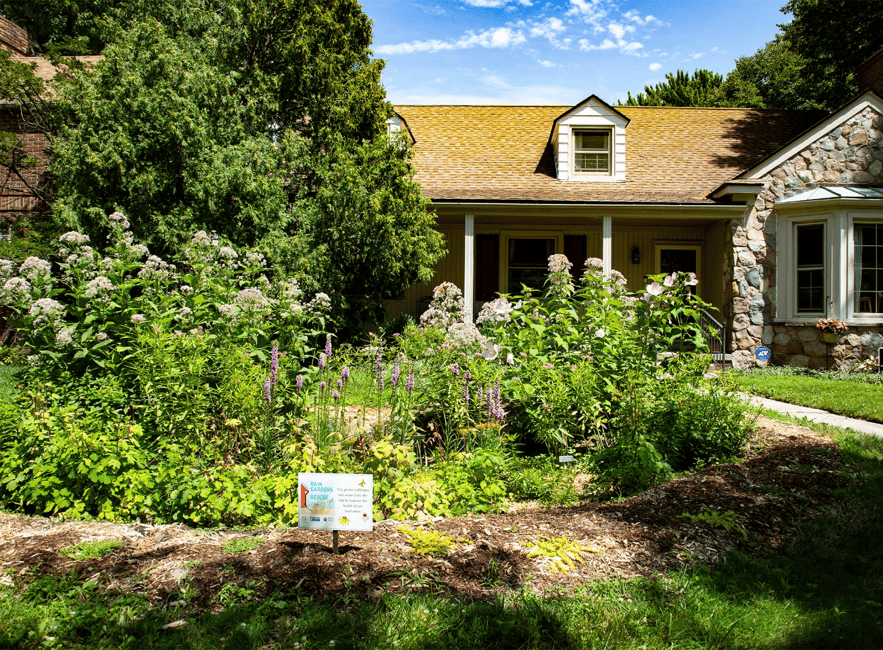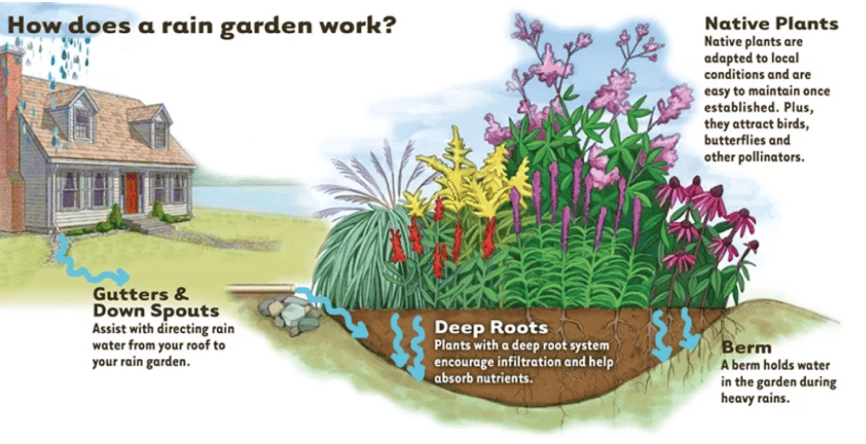Looking for some lawn improvements this summer? Tired of your driveway and yard ponding water after it rains? Why not install a rain garden?! Rain gardens are growing in popularity throughout Southeast Michigan, given the many ecosystem benefits and what they provide to homes and homeowners. If rain gardens are new to you, this blog will guide you through the key steps to creating a beautiful gardenscape in your own backyard.

Let’s start by addressing the obvious question: What is a rain garden? Rain gardens are landscaping features that are often built on residential or commercial properties. They are depressed areas designed to capture and infiltrate rain water and stormwater runoff from impervious surfaces like driveways, rooftops, and parking lots.

Source: Greater Lansing Regional Committee for Stormwater Management (https://www.mywatersheds.org/rain-garden-101)
Rain gardens are capable of improving water quality and reducing some flooding thanks in large part to the large, deep roots the plants have. The vegetation planted in a rain garden typically has roots that are as long below ground as the plant is tall above ground! These roots allow for water to infiltrate down into the soil, rather than pooling on the surface. They also help to absorb nutrients and pollutants as the water seeps into the soil. Native plants often work best in rain gardens. Not only do they often have long roots, but they also encourage local pollinators to pay a visit to your backyard.
Now that we’ve learned about the importance of rain gardens, let’s get into building them! Here are some important things to consider when building a rain garden:
- Evaluate your existing soil type. Soil plays a big role in how water infiltrates into the ground; it’s important to know if you need to supplement your soil with a soil mixture that promotes infiltration and that will also be good for your native plants. Compost mixtures are always good to consider adding to your soil, since they can help with both water infiltration and plant growth.
- Understand where rainwater flows on your property. Is there a place that rainwater naturally collects? This will help you understand the best location to install your rain garden, so that it can help manage water runoff in your yard.
- Think about the design of your rain garden! When considering the size and shape of your rain garden, you’ll want to think about how much water you want to infiltrate.
- Select colorful varieties of plants native to our Michigan area that will thrive with the environmental conditions you design into your rain garden (amount of water, sun/shade, soil mix, etc.).
Once you’ve worked through the planning process and installed your rain garden, you get to watch it grow! Maintenance for rain gardens is often minimal, but in the first 1-2 years, you may want to check in every now in them to make sure your plants are getting enough water and you aren’t getting too many weeds. It usually takes about three years for your rain garden to show its true beauty, so don’t be surprised if it looks a bit rough in the meantime. As long as the garden is given the resources it needs, it will bloom.
If you’re interested in learning more about rain gardens and having someone guide you through the process of installing one, be sure to check out the Washtenaw County Water Resource Commissioner’s Master Rain Gardener Class. This class is free during the COVID-19 pandemic, and can be easily accessed online. Also be sure to check out the resources listed below. Good luck gardening!
Rain Garden Resources:
SEMCOG’s Green Infrastructure Resources
Friends of the Rouge Rain Garden to the Rescue Program
Rain Gardens in the Watershed with the Clinton River Watershed Council
Learn to Plant a Rain Garden with the Huron River Watershed Council
Eight Simple Steps to Creating Rain Gardens with MSU Extension
Using Rain Gardens to Improve Water Quality with MSU Extension

Leave a Reply